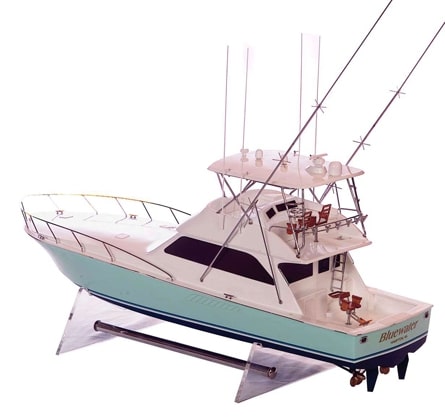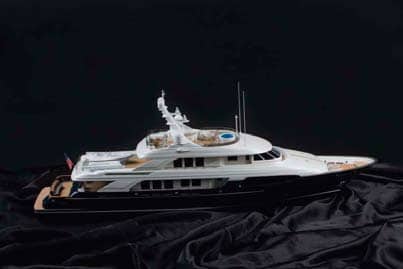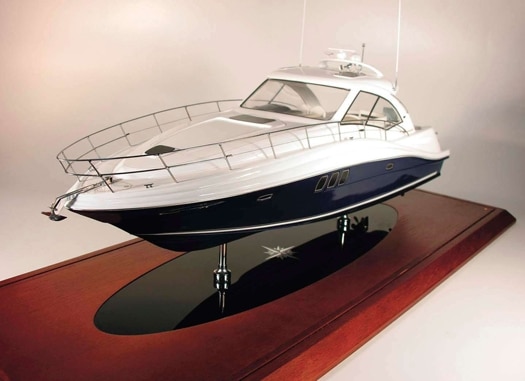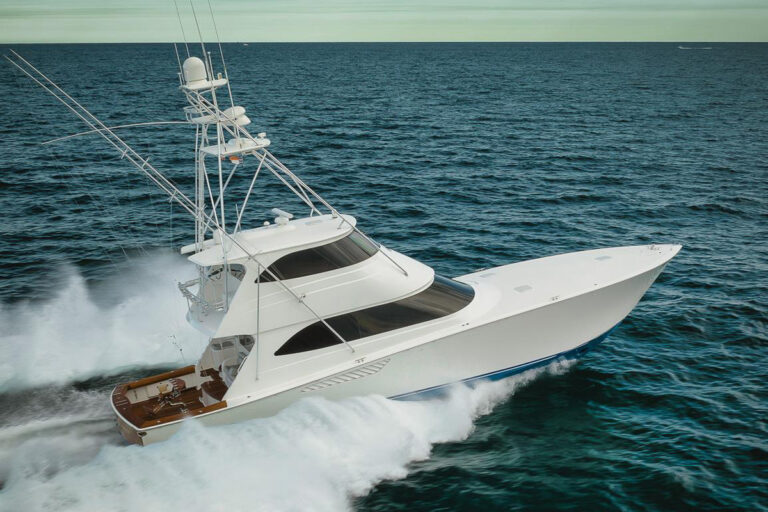
ShipModels445.jpg
There is a story about the builders of model yachts that must be apocryphal, because I’ve heard it from two yacht owners who had commissioned models from different builders. Truth or myth, it sheds some insight on the world of yacht models, and it goes like this:
After spending dozens of hours measuring all aspects of the real yacht, after getting precise samples of everything from the hull paint to the fabric of the bimini top, and after taking reams of notes on such minutiae as whether the cabin windows have Levolor or Hunter Douglas blinds, the model maker was finishing up his research to start building the scale model. As he prepared to depart, he had one last question, “Oh, by the way, what brand of champagne do you drink?”
The yacht owner was caught off guard. “Why do you ask that?” he asked.
As if speaking to a child, the model builder replied, “So I can put the proper label on the champagne bottle by the cockpit table!”
Assuming the common scale of yacht models at ¼ inch to 1 foot (which would turn a 100-foot yacht into 25-inch model), that champagne bottle would barely be 1/4 -inch high and the label perhaps 1/16 inch, or smaller than the tip of a lead pencil. Heaven forbid that it should be a Taittinger label rather than Cristal!
It’s clear that this is not the toy boat that you pushed around the floor as a toddler, so let’s look at the world of miniature yachts. For the sake of simplicity, there are three types of models and you can differentiate by asking yourself, “Does it look like a toy, a model, or a miniature yacht?”

| | |
Toys are the tinplate or plastic boats designed to take a beating from children and, though they have become collectible in their own right, are not precise replicas in any way.
Plastic models are what you probably put together as a kid, assembling the myriad parts of a Revell Chris-Craft kit and trying to keep the glue from getting on everything.
Whether you call them yacht miniatures or scale models or simply yacht models, the degree of detail in the final category is simply extraordinary. Each is as much a work of art as a rare painting, and just as individual. Take the Scale Reproductions 24-inch model of Jimmy Buffett’s 42-foot Margaritavich sportfisher: look closely in the cockpit and you’ll find a pair of Buffett’s trademark flip-flop sandals with a broken strap!
Venture capitalist Tom Perkins is a connoisseur of fine yacht models and has had models of his last four yachts built by Maine craftsman Rob Eddy, who he calls the world’s finest builder of model yachts. “Unlike the models from virtually all others,” he says, “a photograph of an Eddy model cannot be distinguished from a photograph of the real thing.”
That’s no small praise from the owner of the 289-foot Maltese Falcon, which Eddy turned into an 18-inch model for Perkins’ desktop. Of course, that level of artistry and craftsmanship comes with a price tag: most of Eddy’s models take between 2,000 and 3,000 hours to create and cost between $100,000 and $200,000. That isn’t to say that the makers of less expensive models are not craftsmen, but they may not use 14k gold to replicate all the bronze cleats and winches on the deck or white gold to simulate chromed hardware. They probably don’t put a tiny diamond on the top of each winch, either, but that’s become an Eddy trademark for clients such as Netscape founder Jim Clark and the late Gary Comer of Land’s End.
Seacraft Classics, on the other hand, started nearly 20 years ago by building wooden models of classic sailing yachts and, over the years, has evolved into arguably the major player in the yacht model market. They’ve done that by offering designs from a wide range of popular manufacturers that are individually detailed to create a personalized piece of artwork. Each yacht is finished in the exact color as the original, and is complete with a perfectly reproduced name on the transom and even the yacht club burgee on the bow staff.
While the original Seacraft Classics were either hand-carved or laboriously planked by hand, the majority of the custom yachts are now created using a sophisticated three-dimensional resin printing machine that can create models up to 4 feet long. The official model maker for Sea Ray (Sea Ray Owners Club members get a discount), you’ll also find Seacraft Classics on the websites of companies such as Bertram, Hinckley, MJM, Palmer Johnson, and Marquis.
At Seacraft Classics, each model takes 8 to 10 weeks to create after the customer sends detailed information on hull colors and upholstery, as well as photographs of the name on the stern and the burgee. Customers can add additional detailing, such as a fighting chair, a custom tuna tower, outriggers, or electronics. “We’ve built dozens and dozens of models for owners of Hinckley Picnic boats,” says Howard Learned, president of Seacraft, “and every one every one! was different.”
Though most of the Seacraft models are created by AutoCAD drawings provided by the manufacturers to assure absolute accuracy, the company still takes on challenging custom orders such as several old Trumpy motoryachts for which no plans existed.
Seacraft Models range from around $2,500 to more than $10,000, depending on the complexity and the detailing. A 24-inch model of a Hinckley Picnic boat, with the name, hull colors and cushions correctly detailed, is $2,295 including a glass-enclosed display case. A Sea Ray 55 Sundancer at 29 inches and detailed right down to the swiveling chairs behind the helm is $5,300.

| | |
The latest Grand Banks 41 with Zeus drives had barely touched the water when Gary Isaksen of Isaksen Scale Models had a model ready for the manufacturer to display at boat shows, perfect-right down to to the tiny Zeus drives under the hull. Based in Everett, Washington, Isaksen is unique because he not only builds scale models, but he also builds tank test models for builders and designers.
Though the tank test hulls are around 12 feet long, the longest scale model that Isaksen has created is 6 feet and, he recalls, “that was a lot of detail work!” That effort hasn’t quashed his interest in large models, and he’s presently negotiating to build a 27-foot highly detailed model of a 400-foot megayacht for the owner’s office.
A look through Isaksen’s photo gallery of finished models on his Web site shows that he’s a regular supplier to builders such as Delta, Nordlund and a host of Far Eastern yards. With a full-time staff of four plus outside contractors, a finished Isaksen model takes about three months after receiving the plans and photos.

| | |
For Rob Eddy, three months is just the start of research, and then the painstaking craftsmanship begins for he and his one assistant. Each hull starts with basswood below the waterline and a single block of mahogany above the waterline, shaped to exacting tolerances.
If you’ve seen some of the mass-produced model yachts referred to by collectors as “fundamentals,” you will understand how the slightest error can turn a boat into a caricature. “I know one yacht designer,” says Eddy, “who received a not-inexpensive model that was all wrong to his eye. He said he wouldn’t even burn it in his fireplace!”
But getting the lines right is natural for Eddy, who can take months or even years super-detailing each model. Consider a teak deck, for example. In the past, Eddy meticulously cut each paper-thin decking plank from real teak and then applied each plank individually. The addition of a $17,000 laser-cutting machine to his shop has reduced that process but, to meet his standards, all the wood around a hatch still has to be hand-laid so the grain is in the proper direction.
For Maltese Falcon, the huge Barient winch drums were only the size of a pinhead on the model, yet each had to be individually turned to perfection. The mast alone on a yacht can take weeks to craft from wood to the exact shape, and that’s only the start because rigging a model yacht with gossamer wire (even thread looks out of proportion on a model) is a project for only the steadiest of hands.
“What we’re creating,” says Eddy, “is a three-dimensional piece of art. But this is often a misunderstood artistic endeavor. An owner of a large yacht who wouldn’t think twice about buying a painting for $150,000 can agonize over commissioning a model that might take two years to complete.”
In the end, however, yacht owners commission models of their pride and joy for a variety of reasons. For some, it reminds them of the pleasure of owning a fine yacht and the good times spent aboard. For others, it is a tribute to their own good taste. And for yet others, it is a work of art no less desirable than a fine painting or sculpture.
Whatever your reason, there’s a model of your yacht waiting for you.









